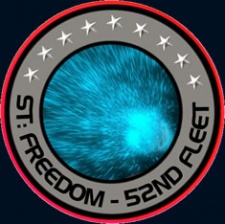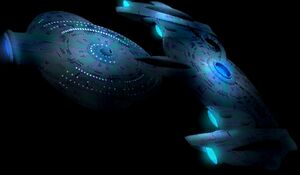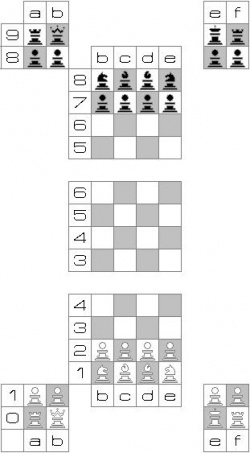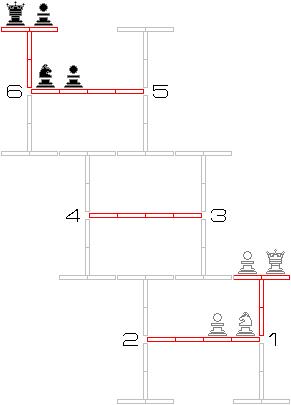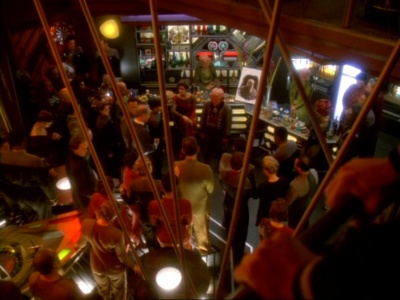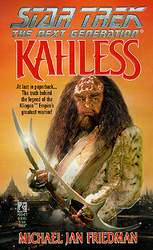Newsletter/Summer 2008
Newsletter for the Star Trek: Freedom Wiki, Summer 2008 edition. To obtain a larger view of any of our pictures in this issue left click on the picture you wish to see. To post feedback click on the Discussion tab.
To see previous editions of the newsletter, visit The Archive
Fleet Update and Missions
- USS Spectre Mission: When Poachers Come to Call
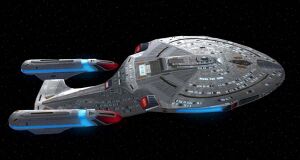 The USS Spectre: A true stealth ship
The USS Spectre: A true stealth ship
The USS Spectre has been ordered by Fleet Command to the Class M world Ushar Prime, the home world of the Ushari, situated close to Theta Draconis & approximately midway between the Ferengi alliance & the Cardassian Union. It's mission now is to investigate why trade has suddenly ceased in regards essential Dilithium supplies. There are indications that the involvement of a new & possibly dangerous benefactor may have soured relations between the Federation & the Ushari. Whether or not this is the case however, remains to be seen.
- USS Hades Mission: Tribuo Senatus
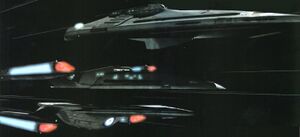 USS Hades: Tri-vector Prometheus class ship.
USS Hades: Tri-vector Prometheus class ship.
The delegates on the planet below have started negotiations, but so far they have been rough. The Praetor himself has shouted down some of his own senators. Meanwhile back on the Hades the crew had a buffet luncheon and tour for the Romulan Commander and three of his officers from the Donatra. Will xenophobia and old hatreds make the mission for successful treaty negotiations between the Romulan Star Empire and the Federation stalemate?
- USS Boudicca Mission: Swords to Ploughshares
The Boudicca has arrived at the Tobias System, only to find that the device they are seeking is not where they were led to believe it would be. They have discovered that it has been concealed not on an orbital moon, but on Tobias V itself. An away team has been sent down to attempt to gain access to the device so that they may disable it, but their task is the harder since they are dealing with a pre-warp civilisation. The away team is disguised as native Tobians and concealment of our technology and identity is necessary in order not to break the Prime Directive.
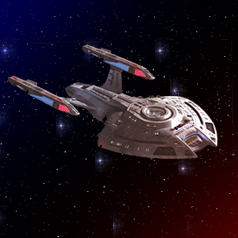
- USS Mithrandir Mission: Wagon Train Amongst the Stars'
The crew of the USS Dennison has found a new home in the USS Mithrandir-A, a nova class vessel. It was recently undergoing trial runs when it was pressed into service to escort a rag tag fleet of freighters filled with colonists from New Eden to their new home. The Mithrandir has just arrived at New Eden where final preparations are being made for departure. Their journey to the New Edenite's new home will be through the Falengi Expanse, a short cut to the Gamma Hygachi Orestes System. The Falengi Expanse, however, is filled with gravimetric disturbances and sensor limitations. But the reduction of seven months from their travel time makes it the only way to ferry so many people before they run out of supplies.
- USS Rosenante Mission: Letters of Marques
When the Prince of Meldovia is kidnapped by Orion Pirates on his way to the peace negotiations that may well end 400 years of war, the crew of the Rosenante are called on by Admiral Talbot of Star Fleet Intelligence to infiltrate Orion Syndicate space and affect his rescue. Using her untried Stealth Systems, the Rosenante manages to make its way deep into the heart of Orion Space, where they send three away teams to the surface in Barakos IV to search for information that may lead them to the Prince before it's too late. With time running out the Crew of Rosenante desperately work to save two planets from the brink of renewed hostilites under Letters of Marques.
Three Dimensional Chess
by Frank Truelove a.k.a. Lanista on Mithrandir
This article assumes familiarity with normal chess. What follows is 3D-Chess specific.
The Boards(s)
There are 7 separate boards. 3 (main) 4×4-square boards (Even-numbered Levels)
4 (moveable) 2×2-square boards (Odd-numbered Levels)
The ranks are numbered 0-9 and the files designated a-f. The boards overlaps when taken together as one playing surface, and the 3D chessboard is similar to a staircase with gaps. Control of the moveable boards to bridge the gaps becomes crucial during play.
Move Notations in 3 Dimensions
In notation for a game played, vertical position is designated by a number from 1-7, counting up from the bottom, with 1 being on an inverted moveable board suspended from White’s starting area and 7 being a moveable board positioned above Black’s setup zone. This 'altitude' indicator comes after the normal notation of piece/starting square/destination square. Some rules place the vertical position number in brackets or parentheses.
Relocation of Moveable Boards
Since it is impossible to move directly from one fixed board to the next, play requires mastering the tactics of control of the moveable boards. Think of them as 4-man shuttlecraft. Gaining control of them, and positioning them properly to facilitate an attack on your opponent’s King is what sets the strategy of this version of chess apart from that of the original game.
You begin play as the controller of the 2 moveable boards that start on your setup board. You can gain control of an opponent's board by occupying it uncontestedly. (Moveable boards that are vacated voluntarily remain controlled by their most recent controller.)
Moving a moveable board counts as a move. A player cannot move a piece and a moveable board at the same time unless the piece is a pawn on the board moved.
To transfer a moveable board to a new peg, the player must not be left in check by the move, and the moveable board to me relocated must either have only 1 of the player's own pawns on it or be empty of pieces.
A moveable board (occupied by a pawn or not) may move 1 'step' along a main board edge to another peg on the same main board. It may not be moved to the diagonally-opposite corner of that main board.
A vacant moveable board can be switched to the opposite end (top or bottom) of the same peg. This means a moveable board placed on the dorsal side of a main board may be moved to the ventral side, and vice versa.
A vacant moveable board can be moved to the board corner directly above or below the moveable board's present location. A moveable board on the top of a lower main board may be moved to the bottom of the next highest main board. A moveable board on the bottom of a higher Main board can be moved to the top of the next lowest Main board.
The peg-positions where moveable boards may be placed are referred to as King’s Level or Queen’s Level and further designated by a number, as in "Queen's Level 3." Each peg is designated by which side of the board it is on (King’s side or Queen’s side). King's Side and Queen's Side pegs are numbered (see Figure 2).
Obviously, a moveable board cannot be placed where there already is 1, though a moveable board above and below the same main board can share the same peg (top/bottom).
Movements of the Chess Pieces
Pieces are moved in exactly the same when as in normal chess, with 1 exception: after an orthodox chess move, the piece may (as part of the same move) go up or down to a different level, above or beneath the destination square. This effectively means that if there is a space in play above or beneath the destination square, the piece moved can end up on any level up or down from the final square on the board level the move is initiated on. Provided there is a contiguous ‘chain’ of open levels above or below, this would allow moving more than one level vertically. Access to levels is determined by the positions of the moveable boards. It is impossible to move from Level 1 to Level 7 in one uninterrupted movement.
The horizontal component of the move must be executed first. A piece cannot be moved vertically first.
Pieces may be on the same square but on different levels. A piece in a given vertical column serves as a block to movement through that space.
Castling
Castling is a special move of the King. It may be done to either side. King’s side castling is a simple transposition of the king and the rook next to it. Queen’s side castling requires that the Queen’s stating space be vacated beforehand. The king is moved to the Queen’s initial square and the Queen’s Rook is move to the King’s starting place.
In either case, even though 2 pieces are moved, castling is considered 1 move. Castling may not be performed if the King is in check, or would move into check. (In normal chess, the king cannot move through check either. But because castling in this version takes place on the moveable boards, this isn’t an issue.) Neither the king nor the rook to be castled with may have been moved before this is done. If the king and both rooks have been moved, castling ceases to be an option. Castling cannot be made as the first move of the game either.
Trivia
3D Chess appears or is mentioned in the following 21 episodes: TOS By Any Other Name; "Charlie X"; "Court Martial"; "Day of the Dove"; "The Corbomite Maneuver"; "Where No Man Has Gone Before"; "Whom Gods Destroy" TNG: "Conundrum"; "Galaxy's Child"; "Lower Decks"; "Ménage à Troi"; "Pen Pals"; "Q Who"; "Suddenly Human"; "The Nth Degree"; "The Price"; "Unnatural Selection" DS9: "Dramatis Personae"; "Statistical Probabilities"; "The Homecoming" ENT: "In a Mirror, Darkly, Part II"
Acknowledgments
In this article, depictions of boards and pieces were prepared by me and, as such, are original work. I have drawn primarily from the Chess Variant Pages http://www.chessvariants.org/3d.dir/startrek.html and Memory Alpha http://memory-alpha.org/en/wiki/Three-dimensional_chess. Andrew Bartmess http://my.ohio.voyager.net/~abartmes/tactical.htm seems to be the originator of these rules.
Star Trek Freedom Competition Place the Logo
by Anthony Keen
Hey all,
Over the next few months, I am going to be running a series of competitions for you all. If you want to win a t-shirt delivered to your house, with your choice of size, colour and words (example down below to the left) you have to enter our competition.
1st Competition: Place the Logo
Using the the wormhole design I made, your challenge is to print it out and take it somewhere, and get yourself photographed with the logo.
The question is where?
I want to see the printed image and yourself photographed against the most futuristic building you can find.
No photoshopping please, I can tell; anyone I suspect of having a go with some photo imaging software will be disqualified.
Then, send me your photo before the closing date of August 8th 2008. Let me state that winners and all the photos will be published on the site and I won’t enter into any correspondence into why we select any winners.
The Council will look at all entries and the winner will be notified via email.
All entries must include a full address (including country, I am in Australia) and full name, so we know where to send the prize
Happy to answer any questions and I wish you all the best of luck.
PS: There will be 4 more of these giveaways over the next several months... ;)
Get to Know Al Muir
Al Muir is a busy guy here on Star Trek Freedom. He runs a tight ship on the Hades as Captain Devan Sash among his other duties.
What is your favorite color, book, food, drink and movie?
Blue, The Three Musketeers by Alexander Dumas, Anything that won't eat me back, Dr. Pepper (which I have to continuously deny myself in order to loose weight)
Movie? So many movies, so little time. I'd probably have to say..... Best of the Best with James Earl Jones, Chris Penn and Eric Roberts.
What do you do for a living?
I am a second grade teacher. I also teach karate as a secondary living.
You don't regard the Karate teaching as a hobby?
No, not really. Since I make money doing it, I consider it an occupation and myself a professional. Just for the curious, the style of karate is called Kyokushin, which is a full contact style.
What got you involved in teaching Karate?
Now that's a bit of a story. My oldest son has a memory processing disorder. He had no short term memory. We got him involved in karate since we thought that the repetition of the movements to learn katas and forms would help his memory. Katas are a series of moves that simulate attacks from multiple opponents. They kind of look like a violent dance routine.
I participated in classes so that I could help him at home. Pretty soon the instructor said, "Hey, why don't you just join the class." So I did. After a while she realized that I was a teacher and she would ask me to help teach the class. Then she decided to retire. She actually told me that she was leaving the class to me.
I was getting ready to test for my black belt so I said sure. My son, who also holds a black belt, now helps me teach the class. And yes, it did help with his memory and focus.
Where do you live and teach?
California, USA
Other than writing posts in Star Trek Freedom and karate, do you have any other hobbies that you do in your spare time?
Spare time? What's that? I play soccer and help coach my son's team. But raising 3 kids takes up most of my time.
What do you feel is the best most rewarding thing you have ever done in your life?
Having my kids. I'm all about my family. Yes, I do love being a dad. My kids are so different from each other, and each one shows a different part of me.
What got you involved with Star Trek Freedom and writing for characters in a Play by EMail game?
That was so long ago. I actually had never played a PBeM before I joined STF. I really have no idea what had been the thing that made me look it up. But I did a search and found the Federation Gaming Network. That was when I created Gr'iann. He was actually my first character on Deep Space Gamma. Then I joined Freedom Squadron, and the rest, as they say, is history.
When did you join Star Trek Freedom Squadron?
I've been trying to figure that out. I was here when the actual split occurred. But I've been with Freedom since, I believe, 2002.
Have you anything in your background that may have helped you with running adventures on a PBEM game?
I had played RPG's a little, and I had been an actor. I also had been a fan of Star Trek since the Original Series.
What is the hardest part about Star Trek Freedom?
In fact, the hardest part of STF is the time that it takes me away from the kids.
If there was any one thing in the world you could change, what would it be?
Acceptance. I would want the people of the world to be more accepting of things that are different, or that they do not understand.
In your opinion, would that include tolerance?
I'm not a big fan of that word. The work tolerance implies the idea that you grudgingly put up with something. You don't like it, but you tolerate it. Acceptance is more of knowing that the differences are there, and yet you like them, not only despite the differences, but perhaps even because of them.
So what are all the things you currently do on Star Trek: Freedom?
I am currently the CO of the USS Hades, playing Captain Devan Sash. I am also a member of the council, where I seem to have been put in charge of Engineering.
I also am currently playing a Vulcan Counselor, Lt. Alosar, on the USS Mithrandir.
I am also the Academy FO, where I oversee the entrance of new cadets and the assignments to their instructors as Admiral Dar Mace. And then I have an instructor character, Lt. Thrall, a surly, one armed Andorian, who has seen more cadets than he can remember.
I have, or have had, characters on every ship, but most are inactive at the moment.
Which Star Trek character in any of the series or movies did you like the most and why?
Another tough question, just because the choices are so great. I like Picard, as I feel he presents the best of what I aspire to be, and yet remains, in my opinion, a real person.
But the triad of TOS, Kirk, Spock, and McCoy, are a true picture of friendship. You may not always agree with your friends, and there are times that you may want to kick the living……..well you get the idea. But in the end you are still family, still friends. I can't separate out which I like the best, as they are best when they are together.
When and how did you first hear about Star Trek in general?
Now I'm dating myself. I used to watch TOS when it was first aired.
Have you gotten to meet any of the actors from Star Trek?
No. I've never been to a convention, and so I would have to have run into them in life.
Thank you Al and maybe one day you will get to meet one of your favorite ST stars out there in California.
StarFleet Chef's Galley Kohlanese Stew
contributed by Lorna Appleby
This is the stew that was a popular dish available at both Quark's and Deep Space 9's Promenade replimat. However, "Kohlanese" has no relation to the Kohl of the Delta Quadrant.
Ingredients
1 pt. undrained shucked oysters
2 cups milk
1 cup light cream
1/2 tsp. salt
A dash tabasco sauce
Sprinkle of paprika
Butter (optional)
Directions
In a medium saucepan combine the undrained oysters and salt.
Cook over medium heat about 5 minutes or till oysters curl around the edges.
Stir in milk, cream, and hot pepper sauce. Stir in milk, cream, and Tabasco sauce.
Heat through, seasoning to taste.
Sprinkle each serving with paprika; if desired, top with a pat of butter.
Counselor's Corner
Our Klingon Counselor is played by Frank Truelove
Dear Counsellor Qaybe'
What is true courage? How does one know if one has it?
~Quaking
QomwI' (Quaker)
Since no true warrior would admit to quaking unless they were experiencing an earthquake, I must assume you are in geologically unstable vicinity. Hence Qom, to experience an earthquake plus -wI', one who does.
As to true courage, one must know the difference between qajunpaQ (audacity) and toDuj (bravery).
Audacity is something that probably ought not to be engaged in but for which one will be esteemed afterward … provided one survives.
Bravery is one of the hallmarks of a life befitting a warrior. It is hard to quantify, as are all such characteristics. It is far easier to know if one has none than to know if one has any. For example, if your enemies are behind you while you are demonstrating for them how fast you can run, you probably have none.
However, as has been said above, you are probably in the midst of a series of severe tremors, so perhaps running across the dangerous terrain to a position of safety would be called for. And, whether you reach shelter or not, courage will be found in the attempt at the crossing. You will be esteemed for the effort, whether or not you survive.
And that differentiates true bravery from mere audacity.
qeSwI' qaybe'
Dear Counsellor Qaybe'
My problem is my Dad. He keeps on frightening off my boyfriends. He even frightens them off before they become my boyfriends!
He's the ship's Captain and I'm his yeoman so we work together too. Until we moved to a small ship with small quarters, I had to share his quarters so I couldn't even get away from him in my time off. At least now I have a small room to myself, but all the guys on the ship are too scared of him to ask me out.
What can I do?
~ Frustrated
Frustrated daughter (puqbe' mogh),
If I understand your problem correctly, you have a difference of opinion with not only your father but also your commanding officer. Let us suppose, for the moment, that your parents did not have the right to approve or disapprove of any potential romantic partner (parmaqqay). If this were the case, you would have two options that should have immediately suggested themselves.
1) Choose more intimidating boyfriends
2) Assassinate your commanding officer, for which I will lend you my kut’luch or assassin’s blade
qeSwI' qaybe'
Star Making Machine
compiled by herbalsheila
Where do stars come from? How do they form? Have they always been here or, like people, do they have a start and an end?
The answer seems to have been found. Astronomers with NASA’s Jet propulsion Laboratory that manages the Spritzer Space Telescope for NASA’s Science Mission Directorate in Washington have discovered a galaxy that they have nicknamed ‘Baby Boomer’ that pumps out new stars at the fantastic rate of up to 4,000 per year.
In contrast, our own Milky Way Galaxy laboriously churns out only 10 new stars per year.

Using the Hubble and Spritzer Space telescopes and the Subaru Telescope in Hawaii, among others, this galaxy is on its way to becoming a gigantic grouping of stars, one of the bigger galaxies in the known universe. The Hierarchical Model theorizes that galaxies slowly bulk up their stars over time by absorbing tiny pieces of other galaxies, kind of like a parent slowly birthing and raising a few children at a time, given relationship ties.
Instead, "This galaxy is undergoing a major baby boom, producing most of its stars all at once," said Peter Capak of NASA's Spitzer Science Center at the California Institute of Technology, Pasadena. "If our human population was produced in a similar boom, then almost all of the people alive today would be the same age."
The star factory galaxy was spotted due to its intense light. This brightness is a measure of its extreme star-formation rate and has set new records for emitting the most light.
When stars are born, they shine with a lot of ultraviolet light, produce a lot of dust and hard radiation. The dust absorbs the ultraviolet light but, like your car in your driveway sitting in intense summer sunlight, it gets warm and re-emits light at infrared and submillimeter wavelengths. So the Baby Boomer Galaxy stands out from its nearest neighbors with its more youthful glow.
With this galaxy pumping out this many stars at one time, does it pose a threat to us? Using measuring equipment from W. M. Keck Optical Measurement Laboratory which provides a
suite of general purpose and specialized optical measurement instruments including laser guides, astronomers have estimated that Baby Boomer is 12.3 billion light-years away. On a cosmic scale, studying this new young galaxy now is like looking back into the past when the universe was a mere 1.3 billion years old. Scientists presently estimate the universe to be 13.7 billion years old. It is too far away to be any type of danger in the near future for our planet.
"If the universe was a human reaching retirement age, it would have been about 6 years old at the time we are seeing this galaxy," said Capak.
To determine the distance from Earth, measurements were made using radio wavelengths with the National Science Foundation's Very Large Array in New Mexico, USA. This gave astronomers the ability to calculate star birthing and development rate of about 1,000 to 4,000 stars per year. Only 50 million years would then be necessary for Baby Boomer to grow into a large massive galaxy as some of the Milky Way’s neighbors have done. Though nearby galaxies can produce stars at simlilar rates, they tend to be more mature, at only 11.7 billion light-years away or when the universe was 1.9 billion years old.
"Before now, we had only seen galaxies form stars like this in the teenaged universe, but this galaxy is forming when the universe was only a child," said Capak. "The question now is whether the majority of the very most massive galaxies form very early in the universe like the Baby Boom galaxy, or whether this is an exceptional case. Answering this question will help us determine to what degree the Hierarchical Model of galaxy formation still holds true."
"The incredible star-formation activity we have observed suggests that we may be witnessing, for the first time, the formation of one of the most massive elliptical galaxies in the universe," said Nick Scoville, Professor of Astronomy at CalTech in Pasadena, CA, now serving as Department Chair. Dr. Scoville is also the principal investigator of the Cosmic Evolution Survey, also known as Cosmos. The Cosmos program is an astronomical survey designed to investigate the evolution of galaxies as a function of cosmic time and large scale environmental galactic structure.
"The immediate identification of this galaxy with its extraordinary properties would not have been possible without the full range of observations in this survey," said Scoville.
Star Trek Book Review
Submitted by Frank Truelove who plays Lanista on the Mithrandir
Kahless by Michael Jan Friedman, 307 pages, ISBN 0671-00887-0 Cover price $5.99 US, published by Pocket Books, a division of Simon and Schuster, now out of print but can easily be purchased used.
Kahless is the second-best Star Trek novel I have ever read. (The best was The Final Reflection by the late John M. Ford but it is unfortunately out of print.)
Kahless is a TNG story involving Worf, Picard, and the Kahless clone. However, every other chapter is set in the Heroic Age of pre-Empire Klingons.
The plot revolves around a controversial ancient scroll that threatens some very core beliefs about what it means to be Klingon. There is all the combat, intrigue, and swaggering bravado one would expect from representatives of the Warrior Species. It is a fantastic read.
The book closes with an interesting twist regarding the identity of the Kahless clone himself. This turn is somewhat subtle, a characteristic not generally associated with Klingons, but it is put forward in a pleasing fashion.
Kahless contains some rather annoying filler centering on Alexander. If this can be considered the story's main failing even it is redeemed by the statement made in the Epilogue about the importance of family, Klingon or not.
Words of Wisdom
"When you do things right, people won’t be sure you’ve done anything at all." - Anthony Keen
As you look into the abyss, the abyss looks into you. Nietzsche - Jim McCrary
"But we don't beat the Reaper by living longer. We beat the Reaper by living well." - Dr. Randy Pausch
